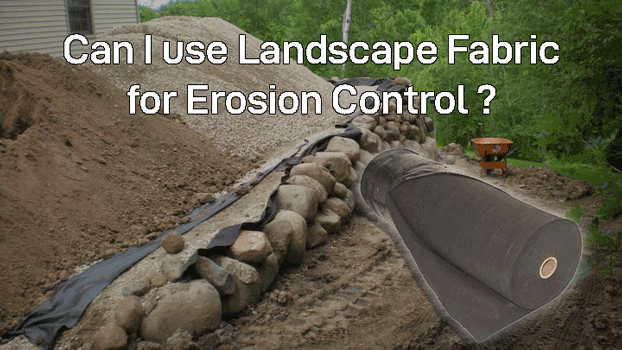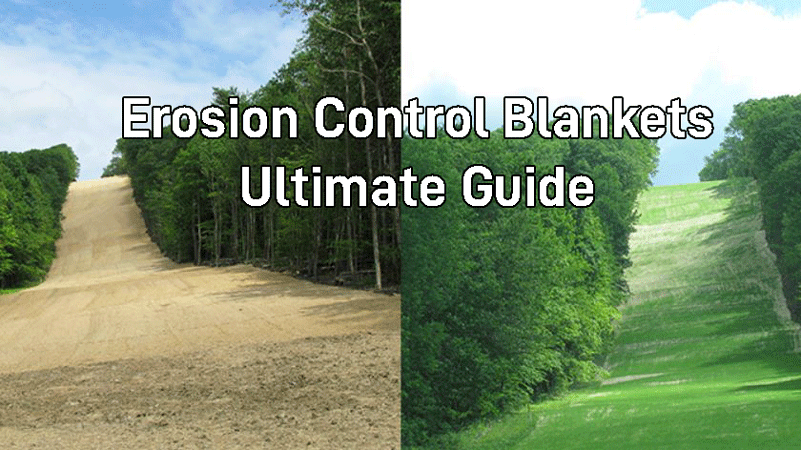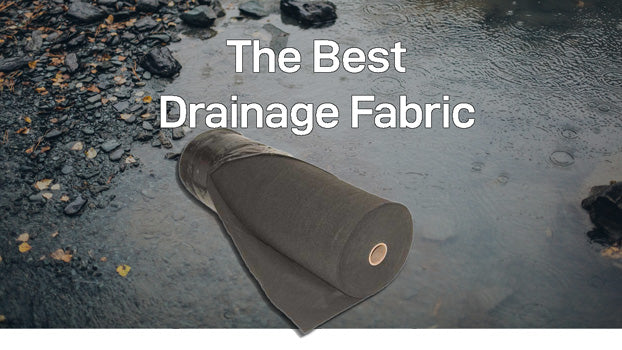Erosion Control Blankets - A Helpful Illustrated Guide

Erosion Control Blanket Before and After Installation
Erosion control blankets (EBCs) (soil erosion control mats) are used on both residential and commercial properties to prevent the topsoil from shifting, saving the roots, and promoting long-term growth. These materials typically include a mixture of natural fibers and synthetic erosion control netting type material. A huge number of landscapes in erosion-prone areas utilize some sort of erosion control blanket or fabric. They're affordable, useful, and easy to install.
Erosion Control Blankets encourage strong vegetative growth on hillsides by providing a structured matrix for grass seed to take root. The established grass root system acts as a stabilizer for embankment soil. These blankets last between 3 months to 3 years and naturally degrade over time leaving only grass behind.
Throughout this article, you'll also learn the following details about erosion control blankets (mats):
- Should the erosion control mat be removed once the desired vegetation is established?
- Help with knowing if you should install one in your project
- Comparisons between erosion blankets and hydroseeding or straw
- Maintenance tips to correctly install and preserve your erosion blanket
Once Vegetation is Established, Should I Remove the Soil Erosion Control Mat?
Erosion control blankets have many benefits, as you'll see later in the article. Removing them might seem like a good idea once the roots are established, but there are many reasons you shouldn't remove them once installed. Getting rid of it too early can ruin everything you've worked for, rendering the process useless.
Here's what you should know about removing an erosion control blanket:
Do Not Remove the Soil Erosion Control Blanket
According to CVTS Landscaping, you don't have to remove the erosion control blanket. As long as it's not causing an obstruction (which it shouldn't), there's no reason to get rid of it. In fact, you can leave it there for grass and other plants you intend to grow later on down the road.

Placing Erosion Control Blanket
Most Materials Decompose
The reason why you can leave your soil erosion control mat in place is because most will degrade over time. Almost all ECBs are either photo-degradable (broken down by the sun's UV rays) or biodegradable (broken down by bacteria/living organisms). Most blankets will degrade over a time period of 3 months to 3 years depending on the blanket matrix and erosion control netting type.
Proper installation techniques promote longevity, allowing your erosion control blanket to remain effective for a long time.
What's Better: An Erosion Control Blanket or Hydroseeding?
Hydroseeding is one of the most popular forms of erosion control.
It's visually appealing since you can watch the protection and growing process.
So, when it comes to erosion control blankets vs. hydroseeding, what's better?

- Hydroseeding requires less labor. As long as you have the proper materials, all you need to do is till the soil and spray the solution. Some installations don't require tilling, and the seed mixture is typically sprayed out onto large hillsides via a pump truck.
- Hydroseeding combines everything in one solution. Every container has mulch, fertilizer, seeds, and everything else grass needs to grow. Superior Ground Cover explains it's an all-in-one liquid however the longevity of the spray can vary. The solution works great for the first application, but you'll have to apply fertilizer again later.
- Erosion control blankets are durable. Unlike hydroseeding, ECBs can be used on rainy, snowy days. Hydroseeding solutions blow away in the wind, though they're designed to withstand rain. Nevertheless, heavy storms can alter the hydroseeding mixture's performance. Erosion control blankets remain intact in all but the most severe weather.
The Bottom Line:
ECBs and Hydroseeding are not mutually exclusive and can be used together to promote rapid vegetation growth and prevent hillside erosion. Both are effective methods for preventing erosion, however, if you are looking for a long term solution which will last for many years to come then either erosion blankets, or a combination of both are optimal.

What’s the Difference Between Using an Erosion Control Blanket vs. Straw for Erosion Control?
Since erosion control blankets can be made of materials similar to straw, it could be a bit confusing to find the difference. Fortunately, you're in the right place to "break down" why erosion control blankets tend to be the best solution to prevent erosion.
Here are the 3 main differences between using an erosion control blanket and blown straw to control erosion:
- Blown straw is loose, and erosion control blankets are woven. When people use straw to prevent or control erosion, they blow it through a machine or toss it by hand. However, erosion control blankets are stretched over the surface and pinned in place.
- Straw takes less time to decompose than most blanket fibers. Straw can break down in less than three months, while erosion control blankets typically last 3 months to 3 years. In other words, you'll have to reapply straw more often than an erosion control blanket, making straw more expensive in labor over time.
- Straw is significantly less effective than erosion control blankets on sloped areas. American Excelsior provides a study that shows straw blows around in the wind and falls downhill. Since ECBs are placed on the soil and they don't move with the wind. Instead, they hold their place and maintain a stable surface for the roots.
How Do Erosion Control Blankets Work?
Erosion control blankets work by enabling vegetation a stable place to grow while the seeds take root. As the vegetation takes root the blankets simultaneously degrade, so that over time your left with a natural erosion protected slope.

ECB Placed on Hillside
Erosion Control Blankets Help To Slow Water Movement
When water hits the material, it slows down quite a bit. Rather than shifting seeds, plants, and roots, the water rolls to the edge and goes downhill. You can use them for the same purpose on flat ground, too. Water naturally erodes the soil, but erosion control blankets slow its effectiveness, hydrating the ground and preventing damage.
ECBs Hold Seeds in Place

Grass Seed Taking Root to Stabilize Soil
Erosion control blankets secure seeds, roots, and stems instead of shifting around. Grass can grow through the dense fibers, keeping it vertically aligned. This benefit is useful when fighting water movement, but it's helpful wherever you live. When seeds are held in place, they're allowed to grow uninhibited.
The reliability of erosion control blankets is directly linked to the materials they're made of. Some blankets are dense and last several years, whereas low-end blankets are looser and less reliable. If you want to learn more about the materials and functionality of erosion control blankets, read on.
What Materials Are Erosion Control Blankets Made Of?
Contrary to popular belief, erosion control blankets aren't all made of the same materials. There are many different options, all of which affect the blanket's usefulness. If you want something that will last a long time and prevent erosion, it's essential to choose the best available material.

Straw Erosion Control Blanket

Coconut Erosion Control Blanket

Wood Excelsior Erosion Control Blanket
Here's what erosion control blankets are made of:
- Straw is a common material used in erosion control blankets. As you read earlier on the page, loose straw is popular for farmers. Straw is lightweight, easy to install, and very effective when woven into an erosion control blanket. It's also one of the most widely available.
- Many erosion nets use coconut fibers. This material is biodegradable and durable. It doesn't come unwoven until it settles into the ground and guides seedlings. It can withstand wind, rain, and many other weather patterns. Although they're not as common as other options, they're quickly rising in popularity.
- Some options are made of wood excelsior. Wood excelsior is thin wood shavings left over from various projects. It's used in everything from packaging and shipping to erosion control. It's woven into a blanket and used to prevent erosion. Although it's not as dense as other materials, it can hold much more water.
- Polypropylene is becoming a top choice for many people. The biggest downside is it's not biodegradable. However, if you intend to grow grass for a long time, the con becomes a pro. Polypropylene erosion control blankets are extremely UV-resistant and much more durable than other organic nets.
East Coast Erosion states all materials must be woven into different patterns that impact their effectiveness. The main similarity is they all need to be porous enough to promote airflow, hydration, and growth. If it's not ventilated, your seedlings won't be able to grow, and the water will push down the soil, causing erosion.
Benefits of Using Erosion Control Blankets
We've covered comparisons, how they work, and materials, so it's time to show you the numerous benefits of owning an erosion control blanket. It doesn't matter if you use it for your backyard, hills, commercial properties, or anything in between; Erosion control blankets have been and will continue to be used for countless years.
Here's a list of benefits associated with installing an erosion control blanket:
- You don't have to worry about uneven soil. Water is known to ripple and roll through dirt, making it loose, rough, and cracked. If you're tired of the bad appearance, an erosion control blanket can prevent further damage. Level the ground, then add an erosion net, spread seed, and watch it work its magic.
- Erosion control blankets are excellent for hilly regions. If your yard has a hill, rain can push mud, rocks, weeds, and debris downhill. Using an erosion control blanket will stop this process in its tracks by rolling water over the blanket rather than the soil. You've probably noticed them on hills around highways and in mountainous areas.
- They break down over time. You don't have to remove the blanket, so it's a one-time process. Proper maintenance allows the blanket to biodegrade, but we'll cover care tips later in the post. It usually takes a couple of years for erosion control blankets to fully break down, but they're non-invasive and out of sight.
- Erosion control blankets regulate hydration and airflow. Your plants will get the perfect mixture of oxygen and water, which are crucial for their longevity. All you have to do is ensure they get enough sunlight for the perfect trio of necessities. Without a net, your plants will be exposed to excessive hydration and flooding.
There are many more benefits of erosion control blankets, including their durability, comparison to similar products, and a wide range of materials to choose from. Another benefit is their easy installation process (once you get the hang of it). Speaking of which, we'll cover the whole step-by-step method in the next section.
How To Install an Erosion Control Blanket
Below is a general purpose installation overview. You should always reference the manufacturers Installation Guide and any technical project specification for your particular application.

1. Get rid of debris, including weeds, rocks, trash, and anything else in your way.
There can't be anything underneath the erosion control blanket, so this step is perhaps the most crucial of all. Once you've cleared the whole area from edge to edge, proceed to the next step.
2. Seed, fertilize, and compact the soil.
After the debris is removed you must seed the area and apply any required fertilizer. Ensure the area is compacted and ready to grow grass in a graded uniform surface.


3. Place the top of the blanket in the trench, ensuring the blanket reaches about one foot beyond the edge.
Use landscaping staples to secure the erosion control blanket to the bottom of the trench, then do the same on the excess 18 inches past the edge. Fill the trench with compacted dirt. Pat it with a shovel to ensure the blanket doesn't move around. You can fill the hole now or at the end of the process.
4. Roll the blanket downhill until it reaches the opposite edge.
Make sure you overlap each net if you have to use multiple. Layers are much more effective than small gaps. Staple the blanket on the other end using landscaping staples.

Slope Installation
Channel Installation
EROSION CONTROL FAQ:
How Long Do Erosion Control Blankets Last?
Erosion control blankets usually last between three months to three years before they biodegrade. However, some nets have a portion that lasts forever. You shouldn't worry about permanent blankets, though; Many buyers prefer this option because they can continue to grow grass and prevent erosion indefinitely.
Below, we'll cover what determines the longevity of erosion control blankets.
The Material Matters
Polypropylene erosion control blankets last much longer than other materials. On the other hand, straw breaks down quicker than most. Neither is unanimously better; What matters most is your intended purpose. Do you want a long-lasting blanket for 10+ years or something that will go away on its own within three years?
Who Should Consider Them?
Erosion control blankets are useful for almost everyone. If you have a yard, hill, or dirt-covered area, you can use these to preserve the area. Even if you have a small grass patch, erosion control blankets can limit water and erosion damage. Let's cover the three primary candidates for erosion control netting.
- Agricultural Land: Farmers and gardeners can protect plants with an erosion control blanket. You could consider introducing straw erosion control as its a typically a lower cost option for larger areas.
- Homeowners: Residential homeowners can enjoy the benefits of erosion blankets and erosion prevention on hillsides and waterfronts. Follow the previously mentioned steps to install the net correctly to encourage vegetation growth.
- Highway DOTs: Many highways dealing with new construction or clearing of land struggle with water erosion. Erosion control blankets are used to hold dirt, grass, and other plants, preventing washout and potential mudslides. They're much more common in regions prone to flooding. Some erosion control blankets are used to prevent rockslides, though tougher materials are typically chosen.
Maintenance and Care Suggestions
Erosion control blankets are relatively self-maintained. You don't need to clean or wash them every day since rainwater does the trick. That being said, there's a handful of maintenance suggestions that could make your erosion control blanket last much longer.
Here's how to maintain your erosion control blanket:
- Don't walk on the net until the roots and soil have settled. If you're planting grass, the seedlings can easily become dislodged, ruining or limiting the blanket's effectiveness. Wait about two to four months until you walk on it. If you don't plant anything, you can walk on it right after it's installed.
- Don't mow the grass until its established. Once you're able to mow the grass, set the mower level to it at least 2.5 inches above the ground. This distance will prevent the lawnmower's blades from pulling the net or seedlings. The same rules apply to weed whackers.
Maintaining your erosion control blanket isn't a lengthy process; It's more of a 'don't do this' issue. Once the roots and seeds are settled, you don't have to treat them differently than you usually would.
Conclusion
Now that you know the benefits, installation, and maintenance procedures for erosion control blankets, you can be reassured these are a great solution for your project. If you want to promote healthy living and growing conditions, erosion control blankets should be at the top of your list.
Here's a quick recap of the post:
- Erosion control blankets typically last between three months to three years.
- ECBs compliment, and increase the effectiveness of hydroseeding.
- Erosion control blankets are made of straw, wood excelsior, coconut fiber, and polypropylene.
Erosion Control Product Options:
Resources:
- Around the Yard: When to Remove Erosion Control Blanket?
- Washington.edu: Erosion Control
- East Coast Erosion: What Is an Erosion Control Blanket?
- Superior Groundcover: What is Hydroseeding? Hydroseeding 101
- CVTS Landscape: Straw Erosion Netting and Successful Lawn Germination

The Eastgate Supply staff includes former landscape contractors and customer service reps who are glad to help out and discuss your project. Reach out and get your project started today!
(800) 583-4891
Support@eastgatesupply.com




